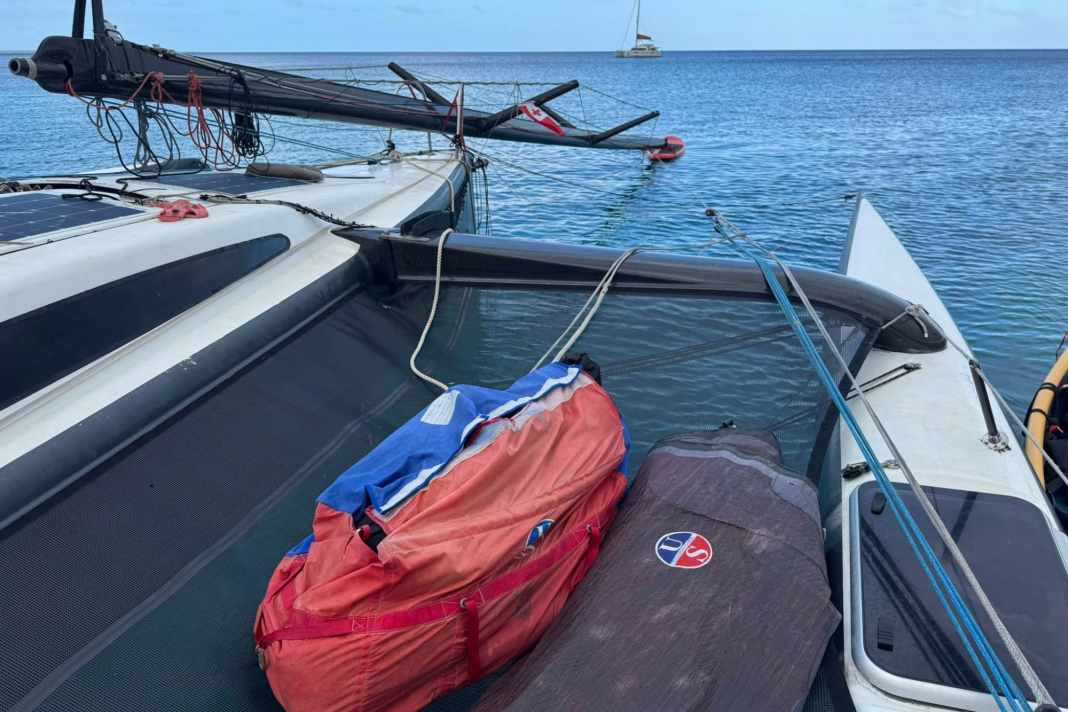





Danish boat builder Jan Andersen and his wife Annette have been sailing around the world on their trimaran "Black Marlin 33" since June 2024. On the way to New Zealand, around 15 nautical miles off the Haʻapai archipelago (Tonga), one of the shrouds snapped at the beginning of last week. The rotating carbon mast tilted to one side and fell.
How the damage was caused
The damage was not the result of heavy weather or gross errors. The wind was blowing at around eight metres per second and the swell was one and a half metres. The torn shroud was made of eight millimetre thick Dyneema material with a breaking load of around 9.9 tonnes. According to Jan Andersen's assessment, the Dyneema was weakened by the strong UV exposure and abrasion on a batten, which ultimately led to a tear. The mast itself weighs 94 kilograms and remained undamaged.
After the accident, the first task was to secure the mast. The owner and his wife took down the mainsail and headsail. They then released the forestay and the other halyards. They were able to pull the mast across the boat and secure it alongside the ship on deck. They then drove the "Black Marlin" to a nearby island using the electric outboard motor. After around six hours, they reached their anchorage with only four per cent of the battery remaining.
Jütt device with on-board equipment
In the calm waters to leeward of the island, the couple began preparations for the re-setting of the mast. New shrouds were spliced, the fittings checked and all work steps meticulously prepared. As the mast clearly protruded over the hull of the "Black Marlin" in the lifting position, a SUP was used to relieve the mast top, which served as an improvised support in the water.
Back to the vertical
The pair only used on-board equipment for the set-up. This is what the setup looked like: The large boom was set up vertically and secured. The main halyard was attached to the boom cam. The mainsheet ran from the boom jib to the stern and was tightened piece by piece using a clamp. The main boom therefore served as a jib boom to improve the angle of pull. The Code 0 halyard secured the mast forward and temporarily took over the function of the forestay. Meanwhile, two side lines held the mast in position like shrouds. After around four hours, the mast was upright again. The duo is now continuing its journey towards New Zealand.
The "Black Marlin"
The "Black Marlin 33" (here in a large portrait) is a lightweight trimaran designed and built by Jan Andersen himself. The hull and superstructure are largely made of carbon fibre. The rotating carbon mast rises around 16.5 metres above the waterline. The Dyneema rig also saves weight, allowing a lot of work to be carried out directly on board without heavy equipment. Despite its low weight, the "Black Marlin" is fully seaworthy and can even be trailered if required. The rudder blades on the outer hulls fold up automatically when the boat touches the ground. With the centreboard raised, the draught is around 40 centimetres. Inside, the trimaran has a light-coloured interior with white surfaces and warm wood accents. The "Black Marlin" is therefore not a Spartan racer, but a well thought-out family boat. The trimaran also became famous for its performance in the Silverrudder single-handed race. Jan Andersen beat his own record in 2021 and sailed the 134 nautical miles around Funen in less than 15 hours.
